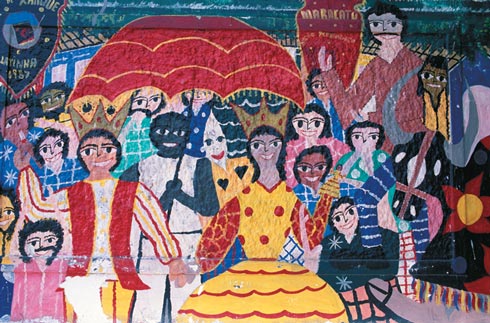"Black" and "White" Not Quite Right
By Christopher Brodie
In Brazil, racial appearances can be deceiving
In Brazil, racial appearances can be deceiving

DOI: 10.1511/2003.38.0
Brazil prides itself on avoiding many of the tensions that plague people in the United States—including racial tensions. In their diverse society, Brazilians embrace the national ideal of a "racial democracy," and there is a high level of inter-racial marriage in the population. Instead of a rigid categorization of "black" or "white" they have the more fluid concept of cor—"color" is a literal translation—which is based on appearance, not ancestry.
Yet Brazilian society is far from utopian. Color and class remain tightly interwoven, a feature that can lead to intricate social dances—appropriate for a country that developed both the samba and capoeira. As one Brazilian scientist explained, "When two Brazilians meet for the first time, one of the first things they do is to try to decide on each other's social class."

The uncomfortable reality is that there is widespread social prejudice against dark-skinned individuals. In light of this under-acknowledged discrimination, Brazilians may be surprised that skin color doesn't predict African genomic ancestry, according to work published in January of this year in the Proceedings of the National Academy of Sciences of the United States of America.
Sérgio Pena and his colleagues at the Federal University of Minas Gerais describe their analysis of the genetic structure of the Brazilian population after testing 373 Brazilians at 10 specific sites in the human genome. Such sites are highly variable in the population, with some versions, or alleles, more common among certain racial or ethnic groups. The 10 sites used in this study were chosen because indigenous Africans tend to have different alleles—so called population-specific alleles—from non-Africans.
Pena's team compiled the results from the 10 markers into an "African ancestry index" (AAI), and proceeded to test their ability to distinguish African and European genomes. They compared 20 natives of Porto, Portugal, with 20 residents of São Tomé Island—once a staging point for Portuguese slaving ships—off the west coast of Africa. There was no overlap in the AAI scores of the European and African groups, confirming the validity of the test.
With this genomic comparison in hand, the next task was to develop a standardized way of describing the appearance of cor. The researchers settled on a simple classification of "black," "intermediate" or "white," based on inner-arm skin color, the shapes of the lips and the nose, and the texture of the hair. At the time the DNA sample was taken, two independent examiners assigned subjects to one of the three groups. The examiners had to agree on their designation for the subject to be assigned to the black or white categories; otherwise the individual was classified as intermediate.
When the DNA samples were analyzed, decoded and compared to the subject's cor, the Brazilian population showed a surprising deviation from the earlier Porto and São Tomé control experiments. In samples from both urban centers and rural districts, the distribution of African alleles was the same for the "black" and "intermediate" Brazilians: Both groups' average AAI values fell between the European and African ends of the spectrum. There was wide variation in the samples—some of the individuals in these groups even showed AAI values in the same range as the Portuguese controls; others resembled the São Tomé Africans. In other words, racial appearance had no relationship to the degree of genetic identity with either the Europeans or Africans. According to Pena "We were surprised at the very poor correlation, but we should not have been. From an ancestry point of view there is almost complete mixture [between Europeans and Africans in the population]."
The white Brazilians also showed a high proportion of African allelic markers, although the distribution was not as pronounced as in the black and intermediate groups. The reason for this became apparent when the identity of the markers was considered—the OCA2 gene, part of the test battery, encodes a protein that regulates pigment production, meaning that the marker itself contributed to the phenotype. When this site was excluded from the AAI calculation, there were no significant differences in the African genomic ancestry of black and white study participants.
Does the same genetic pattern exist in the United States, which also has a large population of African descent? Probably not, says Mark Shriver at Penn State University, whose lab developed the marker set used by Pena. As Shriver points out, "there was no such thing as a one-drop [of blood] rule in Brazil," meaning that Brazil never developed the emphasis on ancestry over appearance that is found in its North American neighbor. As a result, mixed-race marriage per se did not carry the same social stigma in Brazil as it did in the United States. Pena agrees with Shriver's characterization of racial genetics in the U.S., but adds that more work is needed to distinguish the social and genetic elements of race.
Shriver's work is a step in that direction. His research team studies race and genetics with an eye toward public health, focusing on the use of genetic variation in mixed ancestry populations to find disease genes—like diabetes—that affect minority groups more heavily. The outcome of such research can only be helpful for all people. —Chris Brodie
Click "American Scientist" to access home page
American Scientist Comments and Discussion
To discuss our articles or comment on them, please share them and tag American Scientist on social media platforms. Here are links to our profiles on Twitter, Facebook, and LinkedIn.
If we re-share your post, we will moderate comments/discussion following our comments policy.